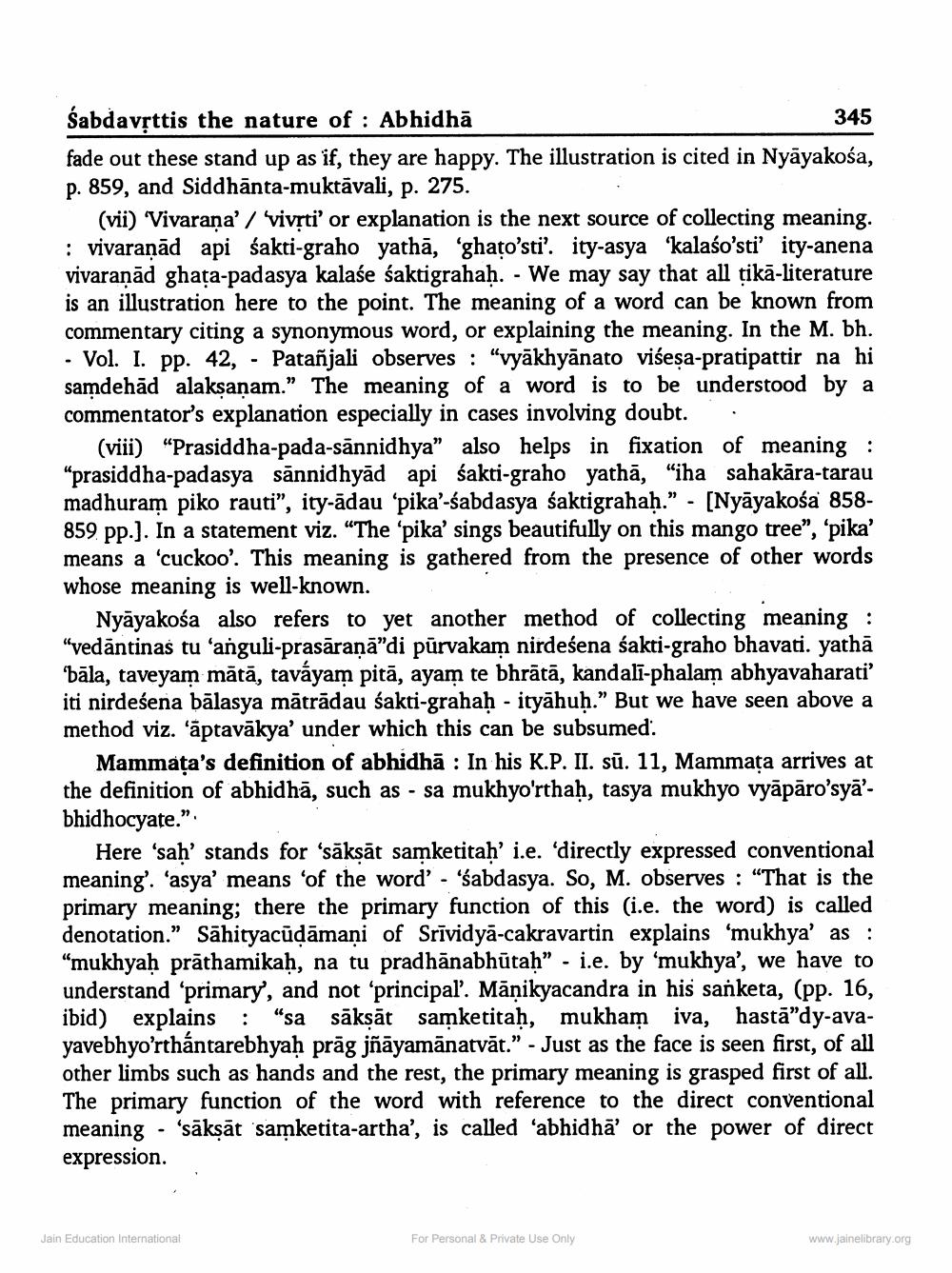________________
Śabdavșttis the nature of : Abhidhā
345 fade out these stand up as if, they are happy. The illustration is cited in Nyāyakośa, p. 859, and Siddhānta-muktāvali, p. 275.
(vii) 'Vivarana' / 'vivsti' or explanation is the next source of collecting meaning. : vivaraņād api śakti-graho yathā, 'ghato'sti'. ity-asya 'kalaśo'sti' ity-anena vivaranād ghaça-padasya kalaśe śaktigrahaḥ. - We may say that all tikā-literature is an illustration here to the point. The meaning of a word can be known from commentary citing a synonymous word, or explaining the meaning. In the M. bh. - Vol. I. pp. 42, - Patañjali observes : "vyākhyānato visesa-pratipattir na hi samdehād alaksanam.” The meaning of a word is to be understood by a commentator's explanation especially in cases involving doubt. .
(viii) "Prasiddha-pada-sānnidhya" also helps in fixation of meaning : "prasiddha-padasya sānnidhyād api śakti-graho yathā, "iha sahakāra-tarau madhuram piko rauti”, ity-ādau 'pika'-sabdasya śaktigrahaḥ.” - [Nyāyakośa 858859 pp.). In a statement viz. “The 'pika' sings beautifully on this mango tree”, “pika' means a 'cuckoo'. This meaning is gathered from the presence of other words whose meaning is well-known.
Nyāyakośa also refers to yet another method of collecting meaning : "vedäntinas tu 'anguli-prasārana"di pūrvakam nirdeśena sakti-graho bhavati. yathā 'bāla, taveyam mātā, taváyam pitā, ayam te bhrātā, kandalī-phalam abhyavaharati' iti nirdeśena bālasya mātrādau sakti-grahaḥ - ityāhuḥ.” But we have seen above a method viz. 'aptavākya' under which this can be subsumed.
Mammata's definition of abhidhā : In his K.P. II. sū. 11, Mammata arrives at the definition of abhidhā, such as - sa mukhyo'rthaḥ, tasya mukhyo vyāpāro'sya'bhidhocyate."
Here 'saħ' stands for 'sāksāt samketitaḥ' i.e. 'directly expressed conventional meaning'. 'asya' means of the word' - 'sabdasya. So, M. observes : “That is the primary meaning; there the primary function of this (i.e. the word) is called denotation." Sāhityacūļāmani of Srividya-cakravartin explains 'mukhya' as : “mukhyaḥ prāthamikaḥ, na tu pradhānabhūtaḥ” - i.e. by ‘mukhya', we have to understand 'primary', and not 'principal. Mānikyacandra in his sanketa, (pp. 16, ibid) explains : "sa sāksāt samketitaḥ, mukham iva, hastā”dy-avayavebhyo'rthántarebhyaḥ prāg jñāyamānatvāt.” - Just as the face is seen first, of all other limbs such as hands and the rest, the primary meaning is grasped first of all. The primary function of the word with reference to the direct conventional meaning - 'säksāt samketita-artha', is called "abhidhā' or the power of direct expression.
Jain Education International
For Personal & Private Use Only
www.jainelibrary.org




